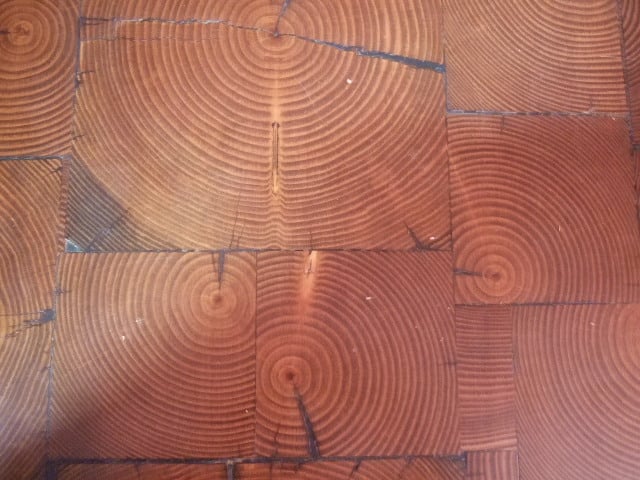End Grain Wood Tile Flooring: An Excellent Pattern For Strength and Beauty
If you are searching for a truly unique option for your hardwood floors, end grain wood tile brings an extra level of detail and history that is unmatched by any other form we offer. At Manomin Resawn Timbers, we believe that the best materials tell a story, so let’s discover the fascinating background of this once popular paver. Each wood tile reveals the character

By Neon Lion | Updated June 24, 2025
If you are searching for a truly unique option for your hardwood floors, end grain wood tile brings an extra level of detail and history that is unmatched by any other form we offer. At Manomin Resawn Timbers, we believe that the best materials tell a story, so let’s discover the fascinating background of this once popular paver.
Each wood tile reveals the character etched into its grain, transformed into a surface as strong as it is stunning. This parquetry flooring is a mosaic of memory, craftsmanship, and enduring style.

What Is End Grain Wood Flooring?
End grain wood flooring is made by cutting timber across the grain rather than along it. This reveals the intricate pattern of growth rings in each block, creating a visually rich and naturally varied surface.
Unlike traditional planks, which show the wood’s lengthwise grain, end grain tiles highlight the tree’s internal structure—its strength, age, and organic design. The result is a dense, highly durable surface that feels as solid as it looks.
With each tile slightly different from the next, end grain wood flooring forms a one-of-a-kind tapestry beneath your feet.
The History of End Grain Wood Tile
End grain wood tile has a surprisingly long and rugged past. These tiles were once used not just in homes, but in warehouses, stables, and even streets—valued for their incredible strength and resilience.
Cut “on end,” these blocks expose the cross-section of the tree, offering up the most durable face of the timber. In the 19th and early 20th centuries, end grain wood tile became a go-to material for industrial floors, absorbing impact and dampening sound in ways other surfaces couldn’t.
Though it began as a utilitarian solution, its natural beauty didn’t go unnoticed. Today, that same material is being reclaimed and reimagined for its toughness and its stunning looks.

The Craft of Making Wood Tile from Reclaimed Timber
Creating wood tile from reclaimed timber is a process that blends old-world material with careful craftsmanship. It starts with salvaging high-quality beams and timbers from barns, warehouses, or industrial buildings that stood for over a century.
Each piece is kiln-dried, stabilized, and carefully cut across the grain into thick, solid tiles. Because reclaimed wood has already endured decades of use, it brings a density and character that can’t be replicated. When shaped into wood tile, this antique, old growth lumber becomes both a visual showpiece and a structural workhorse.
Strength Beneath the Surface: Durability and Benefits
End grain wood flooring is prized for its toughness with each tile built to take a beating and bounce back. The vertical orientation of the grain means the wood compresses rather than splinters, making it far more durable than traditional plank flooring.
Historically used in factories and horse stables, this flooring absorbed shock, muffled sound, and withstood constant wear. Today, it still excels in high-traffic areas like kitchens, entryways, and commercial spaces.
End grain tile resists warping and shifting over time, offering a level of structural integrity that few materials can match.

Design Possibilities with Wood Tile Floor Patterns
Wood tile floors perform well while making a huge visual impact. The exposed growth rings and varied textures in each end grain tile create amazing variation and patterns across the surface.
Throughout history, wood has been used to form patterned floors—most notably in the ornate parquetry designs of 17th- and 18th-century Europe. End grain tiles bring a fresh, textural twist to this legacy, offering the same geometric beauty with added depth and durability.
Whether laid in a brickwork grid or more complex mosaic, reclaimed wood tiles make it easy to craft a floor that’s both artistic and enduring.
Why Reclaimed Wood Makes the Best End Grain Tile
When it comes to crafting wood tile, reclaimed material offers unmatched beauty and integrity. These old-growth timbers were harvested from slower-growing trees, giving them tighter grain patterns and superior density.
Time has already seasoned this wood, making it more stable and less prone to movement. Each tile carries a patina earned over decades, saw marks, nail holes, and subtle weathering that add character to the final surface. Choosing reclaimed wood tile isn’t just about aesthetics; it’s a sustainable choice that gives new life to materials that have already stood the test of time.
A Legacy Underfoot
End grain wood tile is more than just a flooring option—it’s a piece of history, built to last and beautifully unique. With its unmatched strength, striking design, and deep connection to the past, it brings warmth and character to any space.
At Manomin Resawn Timbers, we’re proud to craft reclaimed wood tile that honors the legacy of its source. If you’re ready to bring timeless beauty and lasting performance to your floors, get in touch—we’d love to help you find the perfect fit.
Types of Oak: Reclaimed Oak Woods For The Best Building
Many types of oak have been a cornerstone of building and design for centuries, cherished for both its durability and its beauty. Today, reclaimed oak wood allows us to experience the timeless appeal of this species in a way that honors its history while making it accessible for […]
6 Home Wine Cellar Ideas To Take Advantage Of Reclaimed Wood
At Manomin Resawn Timbers, we’ve had the pleasure of contributing reclaimed wood to a number of custom wine cellar projects. Each design tells a story, blending our expert craftsmanship with the personal vision of the homeowners who commissioned them.
Exploring wine cellar […]

